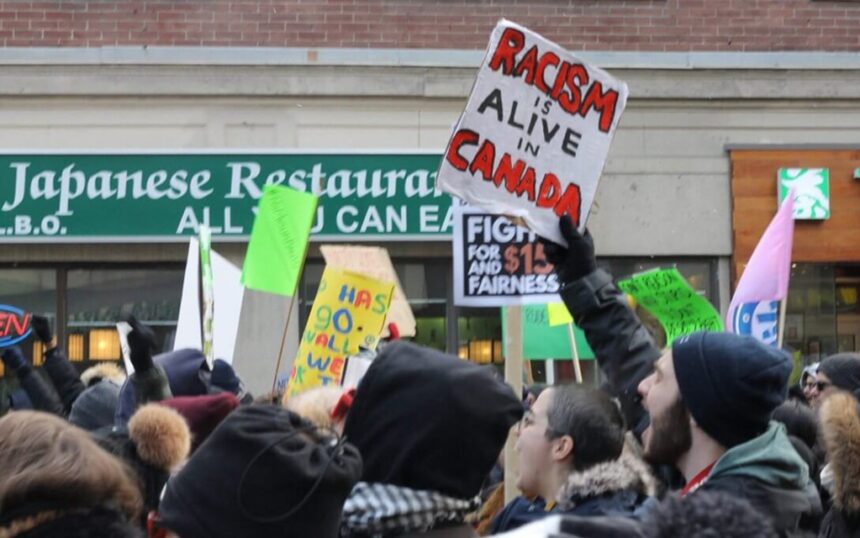Canada is famous for being a multicultural society, welcoming newcomers from all over the globe. In recent years, however, a sharp rise in immigration has become a pressing topic of debate. More people are voicing concerns that these growing numbers may be stirring up racism and hate crimes, leading to real-world impacts on affected communities.
Visible backlash is growing in both public spaces and online, as some Canadians blame newcomers for everything from job shortages to changes in neighbourhood culture. Hate crimes motivated by race and ethnicity are rising, particularly against Black, South Asian, and East Asian groups. This article unpacks the reality behind these tensions, examining how larger immigration waves intersect with rising social divides, and what Canada is doing to address them.
Historic and Contemporary Patterns of Immigration in Canada
Canada’s story is one of migration, change, and debate. While the country brands itself as a welcoming home for diverse cultures, history tells a more complicated tale. The journey from restrictive, race-based rules to today’s points system didn’t happen overnight. Our past shapes the immigrant experience—right now, as mass immigration tests the limits of “multicultural harmony,” old attitudes and new fears can still collide.
Systemic Legacy: From ‘Preferred Races’ to Modern-Day Multiculturalism
Canada’s immigration policy started with deep divides. In the late 1800s and early 1900s, laws favoured immigrants from Britain and Western Europe, while others faced head taxes, outright bans, or quotas. People from Asia, Africa, and even Eastern Europe found doors firmly closed due to race or ethnicity.
While the policies changed over time, the aftershocks continue:
- Selective Entry: Early rules chose immigrants by background, language, and “fit.” Many communities still feel those consequences, with generational gaps in opportunity and acceptance.
- Exclusion and Survival: Groups once excluded had to build lives amid open hostility. The trauma of discrimination lives on, feeding into uneasy relationships between long-standing Canadians and newcomers.
- Multicultural Policy: In 1971, Canada officially embraced multiculturalism. By the late 1960s, the government introduced a points-based system based on skills, education, and need, not ethnicity (Canadian Immigration Acts and Legislation). This helped open doors for non-Europeans, but didn’t erase the old prejudices overnight.
People remember. Attitudes passed down from those years resurface now as Canada welcomes record numbers. Recent newcomers are often more visible and come from a wider range of countries, which can push historic fears back into the spotlight, shaping community acceptance or rejection.
Current Policy Landscape and Public Sentiment
Today, Canada relies on immigration to keep its economy strong and population growing. Recent targets are the highest in modern history. The government welcomed over 430,000 permanent residents in 2022, aiming for even higher numbers in the years ahead (What Is Canada’s Immigration Policy?). The influx includes skilled workers, refugees, international students, and temporary workers, reshaping communities and city skylines.
This dramatic surge has spurred heated conversations:
- Services and Affordability: Many Canadians see stretched schools, rising rents, and crowded hospitals. Surveys show more people now feel immigration levels are “too high” compared to five years ago (Views of Immigration Levels – Public Opinion Research).
- Policy Changes: The government has tweaked student visas, refugee intake, and work permits to balance numbers and economic needs.
- Community Tension: As visible minorities grow, some Canadians feel unsettled by rapid demographic changes. Hate crimes, often rooted in fear and scapegoating, have risen, especially in cities experiencing the fastest demographic shifts.
Polls done in late 2024 confirm the split:
- A strong group wants immigration to focus on those with in-demand skills or family already here.
- Others call for caps, citing housing shortages and costs. Over half say Canada brings in “too many” newcomers at once (Canadian public opinion about immigration and refugees).
Despite a push for anti-racism programs and public campaigns, deep divides remain. As new migrants arrive in record numbers, the fabric of Canadian society is being tested, with public trust and feelings of safety often fraying around the edges.
Mass immigration isn’t just about numbers; it’s about how our shared past, local pressures, and personal beliefs shape what kind of Canada we’re willing to build together.
Rising Anti-Immigrant Sentiment
A surge in immigration has not only brought new faces and cultures to Canada—it has also, sadly, revived old prejudices. As more people arrive, hate crimes fueled by race and religion are surging right alongside. Police data shows hate crimes in Canada more than doubled in recent years. This spike is especially harsh for communities already targeted because of how they look, pray, or where they’re from.
The ripple effects go far beyond statistics. Racialised and religious groups endure not just attacks, but also the threat, fear, and stigma that come with being singled out. Unchecked online spaces serve as megaphones for hate, with real-world pain tied to damaging viral trends, rumours, and scapegoating. For thousands of immigrants, Canada’s promise of safety and belonging is being tested like never before.
Impact on South Asian and Other Racialised Communities
South Asian, Sikh, Black, and Muslim communities are at the epicentre of this wave. Recent years have seen hate crimes against South Asians skyrocket, with incidents rising by a staggering 143% from 2019 to 2022, according to Statistics Canada (CBC report on South Asian hate incidents).
Key trends reveal disturbing realities:
- Racial Profiling and Stigma: South Asians are heavily targeted, both in public and online. Stereotypes often paint them as “job stealers” or “cultural outsiders,” fueling resentment and abuse (anti-immigrant politics fueling hate).
- Attacks on Places of Worship: Sikh gurdwaras and mosques face vandalism, threats, and graffiti, making communal gatherings feel risky.
- Intersection of Racism and Sexism: Black, South Asian, and Muslim women face “double jeopardy”— targeted for both race and gender. Reports show women and girls are often victims of public harassment, slurs, or online stalking.
- Blaming Immigrants for Economic Issues: When jobs or affordable housing get scarce, some blame South Asians and newcomers, turning them into scapegoats for broader problems.
Muslim Canadians, too, have seen steady increases in hate crimes. Police-reported anti-Muslim incidents rose from 36 in 2009 to over 99 in 2014, a worrisome trend that continues (Canadian Guide to Combatting Islamophobia). Black Canadians consistently rank among those most at risk, with racist acts reaching a 339% increase targeting Black children and adolescents as recently as 2024 (Canada’s Anti-Racism Strategy 2024-2028).
Attacks may take many forms, including:
- Physical assault on public transit or streets
- Racial slurs in schools and workplaces
- Vandalism of ethnic businesses and community centres
These patterns create a climate of fear that extends beyond direct victims and into the broader immigrant population.
The Role of Social Media and Online Radicalisation
Social media is a breeding ground for hate and xenophobia. Unregulated forums and viral posts can turn a single rumour or fake news story into a groundswell of anger. Then, real people pay the price.
Here’s how toxic online environments fuel hate:
- Amplifying Stereotypes: Memes and videos spread misinformation, encourage blaming immigrants for societal challenges, and reinforce existing stereotypes.
- Coordinated Harassment: Social networks and closed chat groups are used to coordinate harassment campaigns against individuals and communities. Organised trolling and “doxxing” push people out of online spaces, or even threaten their safety offline.
- Echo Chambers: Algorithms feed users more of what they already believe. People get trapped in a feedback loop of fear, anger, and hate.
- Online-to-Offline Spillover: Threats don’t stay online. Viral hate mobilises action in the real world—from protests outside mosques to hate-fueled confrontations at schools.
Even as law enforcement works to crack down on online hate, underreporting remains rampant. Victims often fear retaliation or don’t trust police to act. The increasing sophistication of hate groups online makes tracking incidents harder.
Complicating matters, spikes in online hate often track global news cycles or political events. Heated debates about immigration policy, or violence elsewhere in the world, fuel more aggressive rhetoric and sometimes violent action at home (Hate crime policies analysis).
Psychological and Social Toll of Hate Crimes on Immigrant Communities
Behind every incident is a wave of unseen pain. Experiencing hate crimes—or seeing it happen to people “like you”—can change how you live, interact, and feel about your place in society.
Common outcomes include:
- Trauma and Hypervigilance: Victims often develop anxiety, sleep problems, or depression. They may avoid speaking their native language in public or even change how they dress to “blend in.”
- Withdrawal From Public Life: Entire communities may avoid public spaces, withdraw from civic engagement, or reduce participation in cultural events out of fear.
- Interrupted Lives: Kids face bullying at school, and parents worry every time their children leave the house. The shadow of hate can follow people to work, class, and daily errands.
- Intersectional Harm: Effects are compounded for those who already face discrimination by gender, sexuality, or migration status. For example, female newcomers may be targeted both for their ethnicity and gender, amplifying stigma and mental health burden.
Studies confirm that victims of hate crimes report higher levels of psychological distress than victims of other crimes (Race Relations in Canada 2024). Underreporting means many silently endure their trauma, further isolating communities that may already feel “out of place.”
Canada’s social fabric takes a hit as trust erodes—not only between newcomers and long-standing residents, but also between minority groups and the institutions meant to protect them. As hate-fueled incidents grow, so does the list of those left feeling unwelcome, unsafe, and unheard.
Political Discourse, Policy Responses, and the Path Forward
As mass immigration meets rising social pressures in Canada, political leaders and government policies have become central to the conversation. Words from politicians and media can calm a storm or fan its flames. At the same time, federal and provincial policies shape the lived reality, whether new Canadians feel supported or sidelined. Tackling racism and hate linked to immigration means questioning who sets the tone, what steps leaders are taking, and where real change is possible.
Responsibility of Political Leaders and Media
The way leaders talk about immigration matters more than ever. When a politician singles out newcomers as the cause of problems like housing shortages or crime, it often gives frustration a target—and can spark or legitimise hate.
High-profile moments make this issue clear:
- Some recent political speeches in Canada have used language like “out of control” or “chaos” to describe immigration. This not only stokes fear but directs blame at visible minorities and new arrivals, as seen in public reactions and online forums.
- In 2024, comments by Ontario Premier Doug Ford linking immigrants to crime without evidence brought swift backlash. He later walked back his words, but the damage lingered. Such remarks can heighten suspicion and justify bias in everyday life.
- In contrast, leaders who emphasise shared identity and unity, like Minister Marc Miller, who warned colleagues to choose their words with care, can play an important role in keeping communities together.
The media also shapes public attitudes. Sensational headlines that focus on immigrant groups in the context of crime, or highlight conflict over culture and identity, feed anxiety and reinforce divides. Responsible reporting counters this by:
- Offering context behind statistics and stories.
- Highlighting voices from impacted communities.
- Correcting misinformation, especially when fake stories circulate online.
With hate incidents doubling since 2019 and anti-immigrant hostility on the rise, leaders and journalists need to recognise their influence—and act carefully. For a deeper read on the link between politics and rising hate, check out this analysis from The Conversation: Anti-immigrant politics is fueling hate toward South Asian people in Canada. Another recent piece asks why so few parties are openly addressing hate’s rise: Why aren’t political parties talking about the rise in hate in Canada?.
Policy Challenges: Integration, Housing, and Social Services
It’s not just language that matters—actual policies make a difference on the ground. The flood of new arrivals over the past three years has tested public systems in new ways. So, how well are government responses keeping up?
Housing and Social Strain
Many Canadians say there’s not enough affordable housing or access to social services. Immigrants face the same struggles and often get blamed for shortages:
- The federal government recently announced a cap on international students and promised to reduce the number of temporary foreign workers, aiming to take pressure off the housing market.
- Despite these moves, waitlists for affordable apartments in places like Toronto and Vancouver continue to grow. Hospitals and schools face growing demand, making integration tougher for new families.
Integration and Anti-Racism Policy
Canada has taken steps to fight discrimination and support newcomers:
- The new Canada’s Anti-Racism Strategy 2024-2028 is a $110.4 million effort aimed at rooting out bias in employment, justice, housing, and health care.
- Provinces, including Ontario, are running targeted programs to address hate, report progress, and bridge divides, according to Ontario’s annual anti-racism progress report: Annual Progress Report 2024: Ontario’s Anti-Racism Strategic Plan.
But these policies face challenges:
- Funding often doesn’t match demand. Rapidly rising population numbers outpace service expansion, from language classes to mental health care.
- Integration support sometimes misses the most at-risk groups—like international students, racialised women, or temporary workers—who are most vulnerable to exploitation or isolation.
- Some anti-racism investments, while big on paper, may fall short in practice. Critics argue progress is slow, with hate crimes continuing despite new strategies (Hate crimes have surged despite Liberal efforts).
Still, these policy responses lay the groundwork for change. By capping permits, investing in anti-racism, and highlighting inclusion, governments can help rebuild trust. But to truly support integration and reduce hate, leaders must act boldly—matching words with real resources, and keeping both the policy and the public conversation on course for a more inclusive future.
Toward a More Inclusive Future in Canadian Immigration
Building a more inclusive future for Canada means stepping up—not just with policies, but with actions that knit communities together and leave no one feeling left behind. Rapid immigration and changing demographics don’t automatically lead to racism or hate. The real challenge comes when society doesn’t keep up with support, understanding, and fair opportunities for everyone.
By looking at what’s fueled recent backlash, we see the need for solutions that don’t just react, but prevent hate from taking root in the first place. A stable, diverse, and welcoming society doesn’t happen by accident. It’s the result of holistic planning, community involvement, and honest conversations.
The Importance of Holistic and Integrated Policies
Mass immigration works best when it’s paired with strong, integrated policies. Relying on numbers alone ignores the real experience of newcomers and long-standing Canadians alike.
Smart solutions include:
- Investing in affordable housing designed to support both new and existing residents, so no one gets edged out.
- Expanding language and job training, helping newcomers build careers and feel at home faster.
- Ensuring access to quality healthcare and education for growing populations, not just patching holes but planning for the future.
When governments work on all fronts—economic, social, and anti-racism efforts—the benefits are felt widely. Canada is slowly moving in this direction, but progress is uneven. Some critics argue that without a full package of support, quick population growth puts too much strain on services and fuels blame (Expanding immigration will not erase racism in Canadian…).
True inclusion means looking at the intersections of policy. Focusing on only one area—like capping visas or running ads—won’t fix deep-seated issues. It takes a more connected approach, one that empowers both newcomers and established communities.
Leadership, Language, and Public Responsibility
Change starts at the top, but it can’t stop there. Political leaders and the media influence how Canadians view each other. When leaders talk about immigrants honestly, recognise challenges without blaming, and stand against hate, it sends a ripple through society.
But we all have a role to play:
- Challenge stereotypes in conversations and classrooms.
- Share positive stories of immigrant success.
- Call out hate when you see it, both online and off.
Canada has begun rolling out action plans to combat hate, rooting new policies in education, community building, and stronger legal tools (Combatting hate in Canada). By naming the problem clearly and supporting those most at risk, we shift the focus from division to allyship.
Empowering Communities to Own the Solution
Communities are the heartbeat of real change. Grassroots organisations, local leaders, and neighbourhoods all play key roles. When people connect through local programs or cultural festivals and support networks, it becomes harder for stereotypes and fear to take hold.
Simple actions make a big difference, like:
- Welcoming new neighbours with local info and friendship.
- Supporting businesses run by newcomers.
- Volunteering for groups that bridge cultures.
Canada’s plans encourage empowering communities as the most effective way to prevent hate and help all residents feel seen (Canada’s Action Plan on Combatting Hate).
Refusing to Normalise Hate
Just because racism has become louder doesn’t make it normal—or inevitable. Backlash tends to spike in times of economic stress or uncertainty, but we can choose not to let it define us.
Putting dignity front and centre means not falling into cycles of blame and suspicion. Instead, we model respect at school, at work, and in daily life. It requires reminders—in our culture, policies, and conversations—that Canada’s strength is found in its differences, not in uniformity.
A more welcoming, safer society starts with each of us. People from every background can work together to push back when hate tries to take root. Real unity happens when shared values outshine old fears.
Related News:
The Rise of Anti-Immigration Sentiment in Canada








